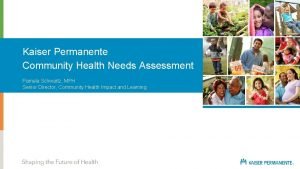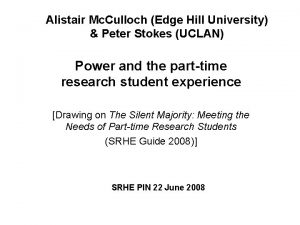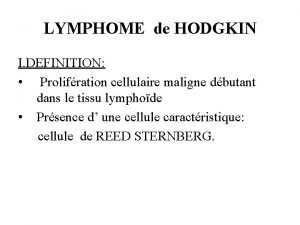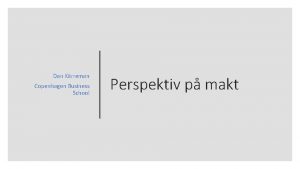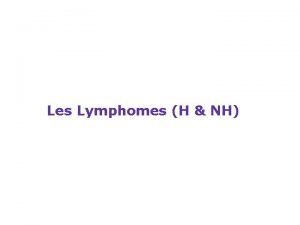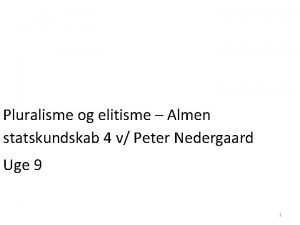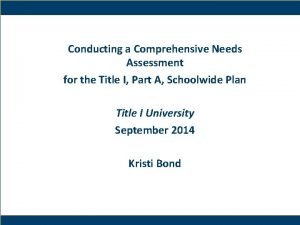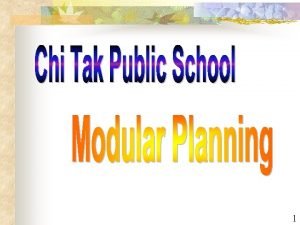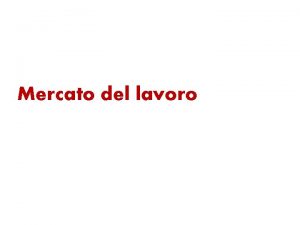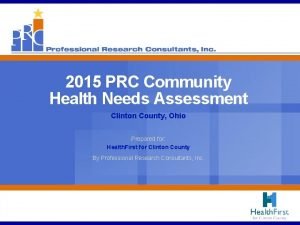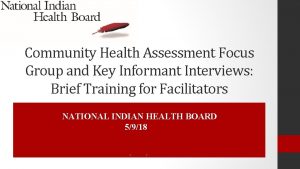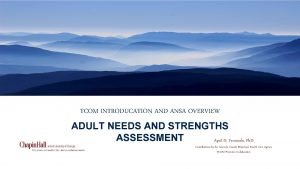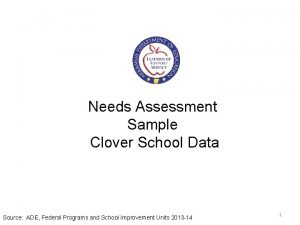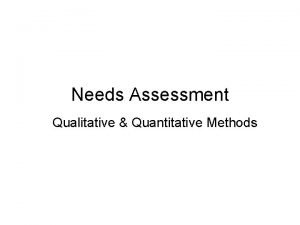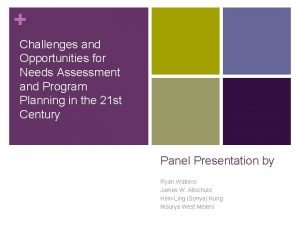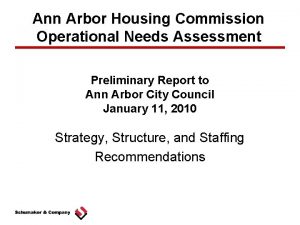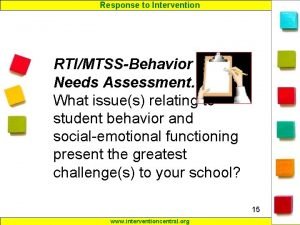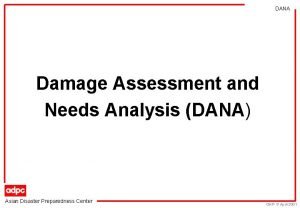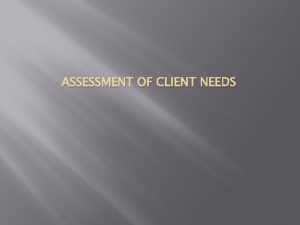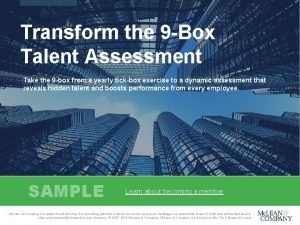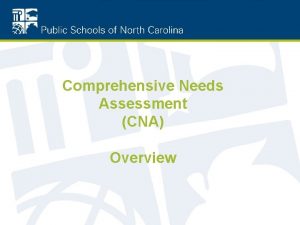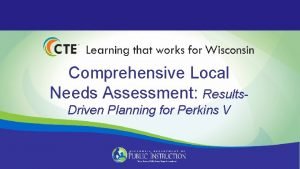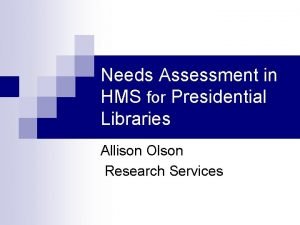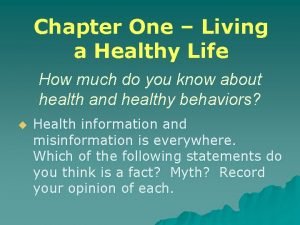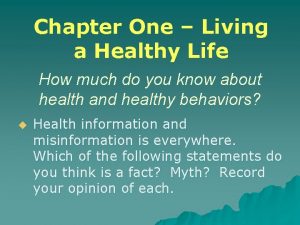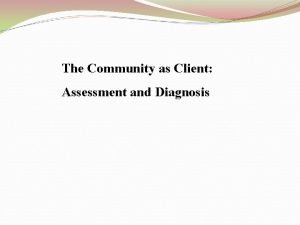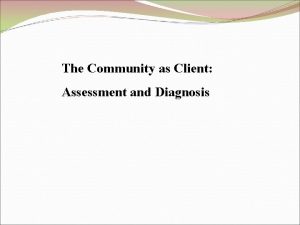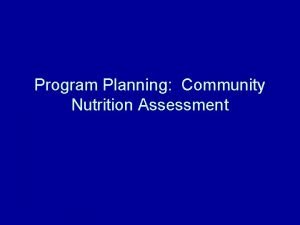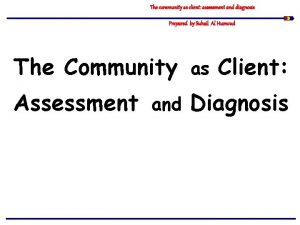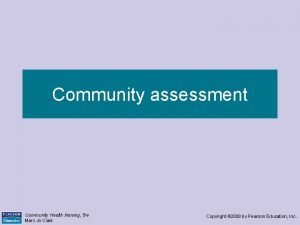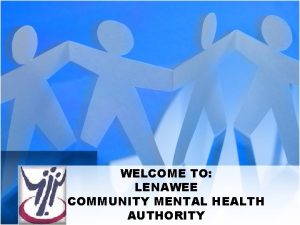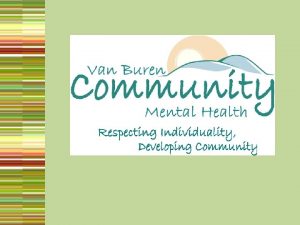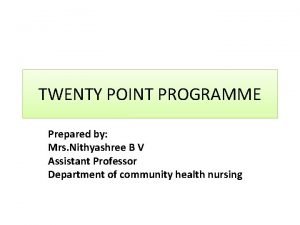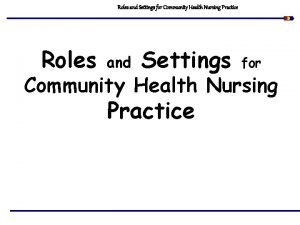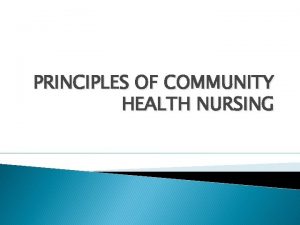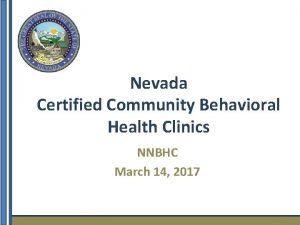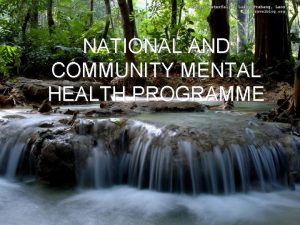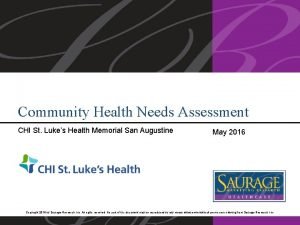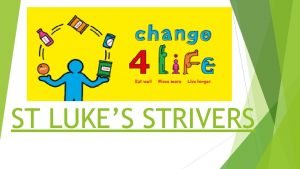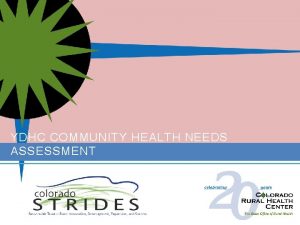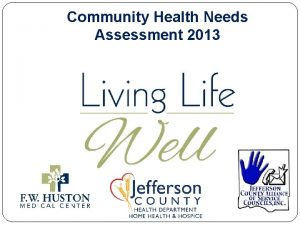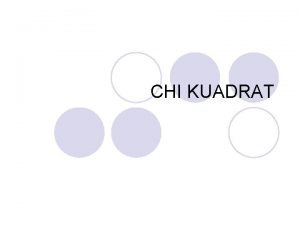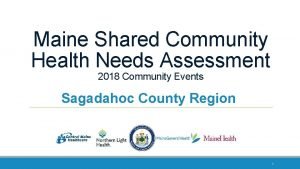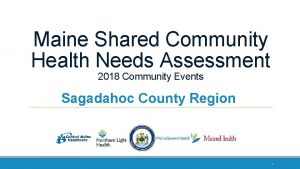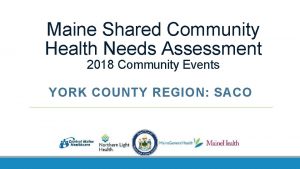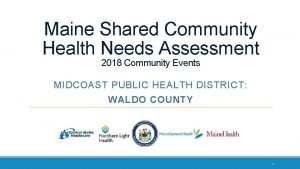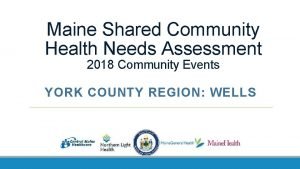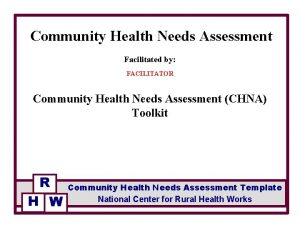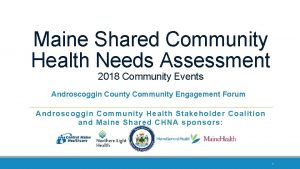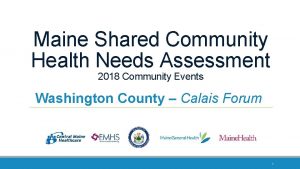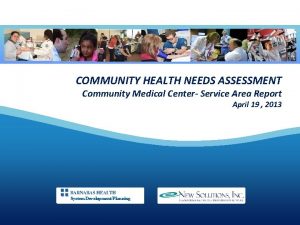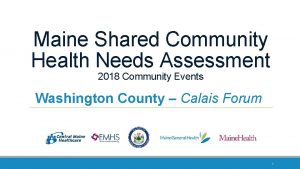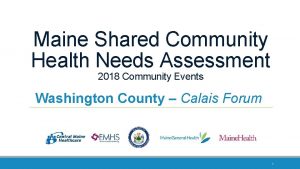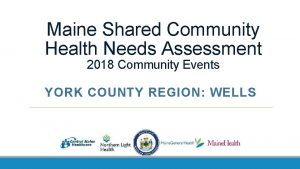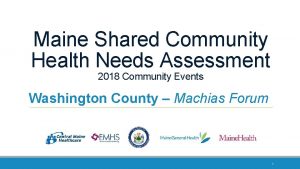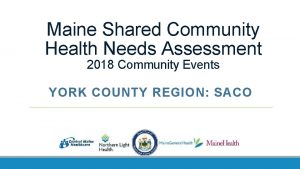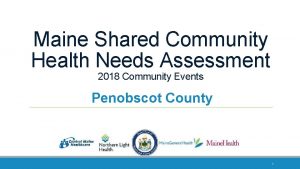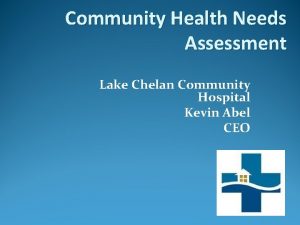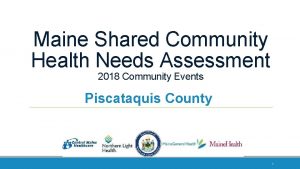Community Health Needs Assessment CHI St Lukes Health
























































- Slides: 56

Community Health Needs Assessment CHI St. Luke’s Health Memorial Master Report May 2016 Copyright 2016 by Saurage Research, Inc. All rights reserved. No part of this document may be reproduced by any means whatsoever without permission in writing from Saurage Research, Inc.

Contents Project Overview 2 Summary & Implications 4 Key Findings Qualitative Quantitative Appendices Consumer Survey Instrument Qualitative Discussion Guides CHI St. Luke’s Health Memorial Master Report | April 2016 11 7 14 50

Overview Copyright 2016 by Saurage Research, Inc. All rights reserved. No part of this document may be reproduced by any means whatsoever without permission in writing from Saurage Research, Inc.

Methodology • This report summarizes the results of both qualitative and quantitative research in the primary service area for each of the 3 CHI St. Luke’s Health hospitals in the Memorial area. – Qualitative inputs were collected via both individual phone interviews with doctors and in-person focus groups. • 1 group of staff members at each of the 5 hospitals. • 1 group among community decision makers external to each hospital. Included in the screening for the latter group were representatives of public health agencies, community health centers, government agencies, community organizations, academics, media organizations, policy makers, elected officials, etc. – Quantitative data were collected via online and phone interviews with 300 healthcare decision makers ages 18 -74 living in the CHI St. Luke’s Health Memorial primary service areas. This includes 134 decision makers from Lufkin, 130 from Livingston, and 36 from San Augustine. • This report summarizes these research results for Memorial. – Individual reports are also available focusing on each hospital's PSA. CHI St. Luke’s Health Memorial Master Report | April 2016 33

Summary & Implications Copyright 2016 by Saurage Research, Inc. All rights reserved. No part of this document may be reproduced by any means whatsoever without permission in writing from Saurage Research, Inc.

Summary & Implications for Consideration Area of need Description Access To Care • Cross-area consistencies include low income, uninsured, indigent, homeless, very old, very young & those with mental/emotional illness. Specialist Services • Shortage of primary care/ family care providers and in other treatment areas requiring many to travel long distances for routine care. Awareness & Communication • What services, care, education & support are available • Raise staff & community knowledge & tolerance levels for cultural, economic and racial differences • Assume a leadership role in educating community leaders & residents on community health, fitness and well-being • Consistent needs identified across these 3 primary service areas include: Community Education - Understanding, preventing, & (if need be) living with stress, diabetes, nutrition, heart diseases, obesity & hypertension - Increasing focus & investment in preventative care, making better decisions and taking better care of self • School aged children, their parents/guardians and seniors identified as primary educational targets • Greater consistency, communication and coordination needed for all community outreach programs CHI St. Luke’s Health Memorial Master Report | April 2016 55

Summary & Implications for Consideration Area of need Special Programs & Improvements Description • Minimizing/eliminating use of ER for primary and routine care • Improving transitional care for discharged patients and reducing readmission rates • Overcoming language barriers (spoken, written and reading) • Developing a plan to attract more primary care physicians to the area & fill high-priority specialist gaps • Identifying transportation alternatives and linking to patient needs • Focusing on and investing in disease prevention • Improving availability and distribution of healthy and nutritious food for those who need it • Tearing down silos among providers, hospitals, community services and care organizations • Identify lower cost sources for meds and link to patients delaying prescription refills • More resources for sexual assault, human trafficking and school violence/bullying services • Support efforts to clean up drinking water/pollution • Explore partnership opportunities with churches, community service organizations, health clinics, etc. • Establish a consistent health screening program for the community • Develop a plan to expand mental health, drug and abuse victim treatment capabilities • Encourage collaboration and effective referral procedures rather than build your own approaches CHI St. Luke’s Health Memorial Master Report | April 2016 66

Key Findings Qualitative Copyright 2016 by Saurage Research, Inc. All rights reserved. No part of this document may be reproduced by any means whatsoever without permission in writing from Saurage Research, Inc.

Qualitative Summary TOTAL MEMORIAL LIVING STON LUFKIN SAN AUGS CONCERNS EXPRESSED REGARDING ACCESS TO CARE Low income X X Uninsured X X X Mental/emotional illness X X X Indigent X X Homeless X X X Drug users X Illegals/undocumented X Uneducated X Very old & very young X 88 X Hispanics who don’t trust doctors X Can’t afford X Rape/trauma needs X Need dialysis X CHI St. Luke’s Health Memorial Master Report | April 2016 KEY FINDINGS X X X NOTE: X = identified as underserved in 2 or more areas • Respondents in the 3 Memorial areas identify several segments in need of additional access. - Low income Uninsured Indigent Homeless Very old & very young Those with mental/emotional illness

Qualitative Summary TOTAL MEMORIAL LIVING STON LUFKIN SAN AUGS NEED MORE PROVIDERS/PROFESSIONALS Local shortages in many/most areas X Children’s doctor in ER X Psychiatrist X Primary care/family care X X X KEY FINDINGS • Respondents in these areas talk first X Endocrinologists X Pediatric diabetes specialist X Adult and child counsellors X CHI St. Luke’s Health Memorial Master Report | April 2016 99 X X NOTE: X = identified as underserved in 2 or more areas and foremost about shortages of primary and family care providers. • In addition, several mention shortages in many treatment areas which is consistent with the long travel distances for healthcare treatment we see in the quantitative results.

Qualitative Summary TOTAL MEMORIAL LIVING STON LUFKIN SAN AUGS KEY FINDINGS COMMUNITY EDUCATION NEEDS Making better choices X X Taking better care of self X X X Stress & stress reduction X X Nutrition/diet/portions X X Drugs (meth/synthetic marijuana) X X Turning 65 (alternatives/choices) Obesity & weight management Heart health & heart disease Diabetes Fitness and exercise X X X • Second in air time was respondent desire X X X to focus more time & educational efforts on preventative care and taking better care of self X X • In addition, respondents focused on specific needs related to stress, diabetes, drugs, nutrition, heart diseases, obesity, fitness, making better choices and behavior modification • Respondents specifically mentioned X Hospice & palliative care X X Containing communicable diseases X X Importance of compliance X Depression X End of life preparation & care X CHI St. Luke’s Health Memorial Master Report | April 2016 10 10 receiving lots of air time during these interviews was a desire to better communicate to all what programs/ services are currently available and how to find out about each one. X Taking responsibility for health/life Services that exist & how contact • An overarching educational need X Cancer Behavior modification X school aged children, their parents/guardians and seniors as primary education targets in many of these need areas. • Finally, there were many requests for NOTE: X = identified as underserved in 2 or more areas better coordination, communication and consistency in designing, communicating and executing future educational outreach efforts.

Qualitative Summary TOTAL MEMORIAL LIVING STON LUFKIN SAN AUGS PROBLEMS/OPPORTUNITIES Reduce wait times to be seen More focus on prevention & wellness X X Too much obesity, heart disease, diabetes Too much smoking, drinking, drugs Too expensive to eat healthy Arsenic levels in drinking water X X X X X Avoiding duplication of tests/script X High risk of diabetes among Hispanics X High cost of docs/meds/dental care X X Patients are numbers & diseases Too many use ER for routine care X X X X X Most don’t know what is available X Reducing readmission rates X Food availability & distribution X Language barriers (speak, read, write) Transportation limitations Cultural/economic/racial bias X X X CHI St. Luke’s Health Memorial Master Report | April 2016 11 11 X Pregnancy among teens (13/14) Health, nutrition, fitness not a priority KEY FINDINGS X X X NOTE: X = identified as underserved in 2 or more areas • At least 2 of the 3 hospital PSA’s defined the following as problems/ opportunities: - Reducing wait times - More focus on wellness/prevention - Too much smoking/drinking/drugs - High cost of eating healthy - Need for clean drinking water - Health & nutrition not a priority - Too many use ER for routine care - High cost of doctors, medicines and dental care (services, deductibles & co-pays) - Language barriers - Limited transportation options - Lack of respect for cultural, economic and racial differences - School bullying/violence/gangs - No place to learn about healthcare - Community credibility of churches and partnership opportunities - Seniors raising kids/grandkids

Qualitative Summary TOTAL MEMORIAL LIVING STON LUFKIN SAN AUGS PROBLEMS/OPPORTUNITIES School bullying/violence/gangs X X Too many solo efforts No place to learn about healthcare Churches credible & open to partner X X X X Nothing to keep young adults here X High stress area X Seniors raising kids/grandkids X CHI St. Luke’s Health Memorial Master Report | April 2016 12 12 KEY FINDINGS X X X NOTE: X = identified as underserved in 2 or more areas • At least 2 of the 3 hospital PSA’s defined the following as problems/ opportunities: - Reducing wait times - More focus on wellness/prevention - Too much smoking/drinking/drugs - High cost of eating healthy - Need for clean drinking water - Health & nutrition not a priority - Too many use ER for routine care - High cost of doctors, medicines and dental care (services, deductibles & co-pays) - Language barriers - Limited transportation options - Lack of respect for cultural, economic and racial differences - School bullying/violence/gangs - No place to learn about healthcare - Community credibility of churches and partnership opportunities - Seniors raising kids/grandkids

Qualitative Summary TOTAL MEMORIAL LIVING STON LUFKIN SAN AUGS SERVICES NEEDED Screening at lab fairs/health fairs X X Post discharge & compliance support X Affordable childcare X X X Expanded mental health services X X X More coordination of patient records Good clinic for victims of abuse Need more collaboration in efforts X X - More health screening opportunities - Affordable childcare - More substance abuse education and care Educating & caring for seniors More substance abuse education & care X X CHI St. Luke’s Health Memorial Master Report | April 2016 13 13 X • Finally, qualitative respondents also identified several specific suggestions of new/improved service needs. Across the three Memorial service areas, the most popular suggestions included: X X X KEY FINDINGS X X X NOTE: X = identified as underserved in 2 or more areas Expanded mental health services A good clinic for victims of abuse Greater collaboration in healthcare services/programs/referrals across all parts of the system

Key Findings Quantitative Copyright 2016 by Saurage Research, Inc. All rights reserved. No part of this document may be reproduced by any means whatsoever without permission in writing from Saurage Research, Inc.

Routine Care What kind of medical provider do you use for routine care or when you are sick? Do you use (ACCEPT MULTIPLE RESPONSES) Type of Provider KEY FINDINGS Doctor's office or private clinic 87% • Memorial residents look first and foremost Community/county health or public clinic Specialist who handles routine care 18% 16% Hospital emergency room Hospital outpatient department Some other place to doctor’s offices or private clinics for their routine care. Specialists and hospital emergency rooms also receive considerable use. 7% 8% 4% Memorial (N=300) CHI St. Luke’s Health Memorial Master Report | April 2016 15 15 • Doctor’s office or private clinic usage is highest among older, insured, more affluent, more confident and Anglo respondents. • In contrast, those more likely to use specialists are non-Whites, more confident and Medicare/Medicaid respondents…and those more likely to use hospital emergency rooms are older respondents with Medicare/Medicaid insurance.

Routine Care What kind of medical provider do you use for routine care or when you are sick? Do you use (ACCEPT MULTIPLE RESPONSES) Do you have a personal or family physician for most of your healthcare? KEY FINDINGS TOTAL MEMORIAL LIVING STON LUFKIN SAN AUGS (N=300) (N=134) (N=36) TYPE OF PROVIDER • Residents in all 3 hospital areas prefer doctor’s offices or private clinics for their routine care. • No significant usage shares were registered across the three PSAs. Doctor's office or private clinic 87% 86% 87% 89% Community/county health or public clinic 7% 8% 7% 6% Specialist who handles routine care 18% 15% 20% 19% Hospital emergency room 16% 15% 16% 14% Hospital outpatient department 8% 8% 9% 8% Some other place 4% 4% 4% 3% CHI St. Luke’s Health Memorial Master Report | April 2016 16 16 NOTE: = significantly stronger/weaker than Total at the 90+% confidence level

Distance Travel for Routine Care How many miles do you travel on average (one way) for most of your family's routine healthcare needs? What is the PRIMARY reason that you or someone in your household travel this distance for healthcare needs? Miles Traveled One Way 39% Memorial (N=300) 24% Less than 10 10 to 20 KEY FINDINGS 35% 21 or more Reason for Distance Traveled Personal relationship - used for years 29% Better quality providers 15% Approved for insurance or health benefits 17% Close/convenient location Specialist 21% 7% Free care 1% Speed of getting appointment 2% Something else 9% Memorial (N=188) CHI St. Luke’s Health Memorial Master Report | April 2016 17 17 • 3 in 10 Memorial respondents have developed long term personal relationships and positive experiences with their family provider and choose to stick with that provider. • Perceived provider quality, insurance acceptance and location also play important roles in their selection of a provider for routine healthcare. • Fully a third of these respondents travel more than 20 miles each way for their routine healthcare. • Younger and non-White respondents tend to travel shorter distances for their routine healthcare…while older and Anglo respondents are more likely to travel longer distances for their routine healthcare.

Distance Travel for Routine Care TOTAL MEMORIAL (N=300/ 188) LIVING STON LUFKIN SAN AUGS (N=130) (N=134) (N=36) MILES TRAVELED ONE WAY KEY FINDINGS Less than 10 39% 26% 49% 22% 10 -20 24% 25% 19% 21 or more 35% 47% 25% 55% REASON FOR DISTANCE TRAVELED 18 18 receive routine healthcare close to home…while most Livingston and San Augustine residents travel considerable distances for theirs. • A long-term personal relationship, Personal relationship - used for years 29% 22% 33% 37% Better quality providers 15% 14% 17% 11% Approved for insurance or health benefits 17% 22% 17% 0% Close/convenient location 21% 24% 17% 26% Specialist 7% 5% 6% 15% Free care 1% 0% 2% 0% Speed of getting appointment 2% 1% 3% 0% Something else 9% 12% 6% 11% CHI St. Luke’s Health Memorial Master Report | April 2016 • Lufkin area residents are more likely NOTE: = significantly stronger/weaker than Total at the 90+% confidence level better quality perceptions and a convenient location are three most popular reasons justifying the distance traveled. • Specialist care is also important for a significant percentage of San Augustine residents.

Confidence How confident are you that you can easily access quality health care when you or your family need it? KEY FINDINGS Memorial (N=300) 67% 27% Likely • For the most part, Memorial residents are confident that they can easily access quality healthcare for themselves and their family. • Confidence was strongest among more affluent, healthy Anglos who haven’t delayed healthcare or prescriptions. Very Somewhat CHI St. Luke’s Health Memorial Master Report | April 2016 19 19 Not too Not at all

Confidence How confident are you that you can easily access quality health care when you or your family need it? TOTAL MEMORIAL LIVING STON LUFKIN SAN AUGS (N=300) (N=134) (N=36) • The same general confidence profile LEVEL OF CONFIDENCE CAN EASILY ACCESS QUALITY HEALTHCARE 20 20 exists in all three PSAs. Very confident 67% 59% 73% 58% Somewhat confident 27% 29% 25% 31% Not too confident 3% 7% 1% 8% Not at all confident 2% 4% 1% 6% CHI St. Luke’s Health Memorial Master Report | April 2016 KEY FINDINGS NOTE: = significantly stronger/weaker than Total at the 90+% confidence level

Delayed Healthcare or Prescriptions Have you or someone in your household delayed health care due to lack of money and/or insurance? Have you or someone in your household been unable to fill prescriptions due to lack of money and/or insurance? KEY FINDINGS Memorial (N=300) 26% 74% • Most of these respondents have never had to delay healthcare or prescription purchases because of money shortage or no insurance. • There are however a sizeable segment of Yes No Memorial respondents who have faced these tradeoff decisions. • The frequency of delayed healthcare is highest among younger, less healthy, less confident and less affluent individuals…those who have delayed healthcare/prescriptions and live with children <18 at home. Likely • In addition to being more often female, those who Memorial (N=300) 19% 81% Yes CHI St. Luke’s Health Memorial Master Report | April 2016 21 21 No delay filling prescriptions exhibit the same profile differences as those who delay healthcare. .

Delayed Healthcare or Prescriptions Have you or someone in your household delayed healthcare due to lack of money and/or insurance? Have you or someone in your household been unable to fill prescriptions due to lack of money and/or insurance? TOTAL MEMORIAL LIVING STON LUFKIN SAN AUGS (N=300) (N=134) (N=36) KEY FINDINGS DELAYED HEALTHCARE DUE TO LACK OF MONEY/INSURANCE Yes 26% 27% 25% 31% No 74% 71% 75% 69% DELAYED FILLING PRESECRIPTIONS DUE TO LACK OF MONEY/INSURANCE Yes 19% 23% 16% 28% No 81% 77% 84% 72% CHI St. Luke’s Health Memorial Master Report | April 2016 22 22 NOTE: = significantly stronger/weaker than Total at the 90+% confidence level • Incidences of delayed healthcare and delayed prescriptions remain fairly consistent across the three Memorial PSAs.

Available Healthcare Services How available are the following to you and your family? % Easily or Usually Available Primary care 94% Eye & ear care 86% Dental care 83% General surgery 82% Outpatient surgery 81% Heart/cardiac care 78% Women's healthcare/surgery 77% Diabetes treatment 75% Care for seniors 75% Gastrointestinal treatment 74% Orthopedic care 73% Neurology services 64% Treatment for stroke 63% Obstetrics services 58% Cancer treatment 58% Pediatric care 56% Memorial (N=300) CHI St. Luke’s Health Memorial Master Report | April 2016 23 23 KEY FINDINGS • Care availability levels in Memorial are highest for primary care, eye & ear care, dental care, general surgery and outpatient surgery …and lowest for pediatric care, cancer treatment and obstetrics services. • Across the various types of care listed, availability tends to be rated highest among more affluent respondents, those who are more confident, have not had to delay healthcare or prescriptions and those with insurance.

Available Healthcare Services TOTAL MEMORIAL LIVING STON LUFKIN SAN AUGS (N=300) (N=134) (N=36) KEY FINDINGS EASILY/USUALLY AVAILABLE HEALTHCARE SERVICES Primary care 94% 89% 96% 97% Eye & ear care 86% 80% 92% 75% Dental care 83% 78% 87% 69% General surgery 82% 80% 87% 56% Outpatient surgery 81% 78% 85% 58% Heart/cardiac care Women's healthcare/surgery Diabetes treatment Care for seniors Gastrointestinal treatment Orthopedic care Neurology services Treatment for stroke Obstetrics services Cancer treatment Pediatric care 78% 77% 75% 74% 73% 64% 63% 58% 56% 78% 73% 74% 73% 68% 69% 59% 62% 50% 52% 54% 80% 83% 78% 77% 80% 78% 69% 67% 64% 62% 60% 64% 56% 67% 69% 53% 56% 50% 42% 47% 56% 42% CHI St. Luke’s Health Memorial Master Report | April 2016 24 24 NOTE: = significantly stronger/weaker than Total at the 90+% confidence level • Primary care remains at the top and pediatric care at the bottom of the availability ratings in all three PSAs. • With the single exception of eye and ear care in Lufkin, the availability profiles in Lufkin and Livingston are similar. • Not so with San Augustine, however, where healthcare levels lag far behind in in 9 of the 16 treatment areas measured. Availability is definitely not a strength of this area compared to the other two.

Biggest Concerns Which of the following concern you most about healthcare in your area? (Max of 3) Higher levels of concern Cost of healthcare 26% Distance to hospital/emergency services 14% Lack of specialiats 14% Lack of primary care doctors 13% Services not covered by insurance Less confident, less affluent, have delayed prescriptions Younger, female, less confident 5% More affluent, Anglo, less healthy Customer service 5% Less confident, commercial insurance Expertise of personnel 5% Have delayed healthcare Little/no insurance Have delayed healthcare 2% Female Memorial (N=300) CHI St. Luke’s Health Memorial Master Report | April 2016 • Memorial residents readily offer one or more areas of immediate concern regarding area healthcare. biggest concern in the minds of these Memorial respondents. • Distance, lack of providers and services not covered by insurance round out the top 5 mentions. 12% 4% KEY FINDINGS • Cost of healthcare is clearly the Cost of insurance Long wait times to be seen 25 25 Younger, living with children, delayed healthcare

Biggest Concerns Which of the following concern you most about healthcare in your area? (Max of 3) TOTAL MEMORIAL LIVING STON LUFKIN SAN AUGS (N=300) (N=134) (N=36) BIGGEST CONCERNS Cost of healthcare 26% 28% 26% 17% Distance to hospital/emergency services 14% 22% 10% 19% Lack of specialists 14% 12% 25% Lack of primary care doctors 13% 18% 10% 14% Services not covered by insurance 12% 11% 17% Cost of insurance 5% 5% 7% 11% Customer service 5% 5% 6% 3% Expertise of personnel 5% 5% 4% 3% Long wait times to be seen 4% 4% 4% 6% Little/no insurance 2% 2% 4% 6% CHI St. Luke’s Health Memorial Master Report | April 2016 26 26 NOTE: = significantly stronger/weaker than Total at the 90+% confidence level KEY FINDINGS • Healthcare costs are the biggest concerns among Livingston and Lufkin residents, while lack of specialists is biggest in San Augustine. • Across all three hospital PSAs, the profile of healthcare concerns closely resembles that reported for the whole of the Memorial area.

Attitudes & Perceptions Please tell me how much you agree or disagree with the following statements about healthcare in your area: % Agree Higher levels of agreement Emergency medical services available 77% Vaccinations available & affordable 72% Younger, more affluent, more confident, no delays Reasonable access to quality health care in my area 62% Healthier, more confident, no delays Adequate skilled health care available for older, frail adults 62% More confident, no delays, no kids at home, Medicare/Medicaid Hospice services are available/affordable 52% Older, healthier, more confident, no delays, Medicare/Medicaid Children have access to nutritious food 51% 35 -54, confident, living with kids People have access to basic, affordable health care 50% Younger, healthier, no delays Seniors get help they need to stay in their homes 46% Medical care available & affordable during pregnancy Seniors get enough nutritious food Access to injury/violence prevention programs 44% 41% 38% Memorial (N=300) CHI St. Luke’s Health Memorial Master Report | April 2016 27 27 KEY FINDINGS Younger, more confident, better health Female, older, more confident, no delays, no kids, Medicare/Medicaid Younger, more confident, living with kids More confident, no delays, • Among Memorial area respondents, the highest levels of agreement are for the availability and affordability of emergency services and vaccinations. • The lowest level of agreement among these Memorial respondents are recorded for access to injury/violence prevention programs, seniors getting enough nutritious food, medical care during pregnancy, and seniors getting the help they need to stay in their homes. • In addition to the profile differences highlighted, higher levels of agreement for all statements came from the healthier respondents who were more satisfied, most confident and got the most choice in where they go for healthcare.

Attitudes & Perceptions What kind of medical provider do you use for routine care or when you are sick? Do you use (ACCEPT MULTIPLE RESPONSES) TOTAL LIVING Do you have a personal or family physician for most of your healthcare? MEMORIAL STON LUFKIN (N=300) (N=134) SAN AUGS (N=36) KEY FINDINGS PERCENT AGREE WITH EACH STATEMENT Emergency medical services available 77% 65% 86% 67% Vaccinations available & affordable 72% 68% 75% 67% 62% 53% 68% 61% 62% 59% 64% 61% 52% 51% 61% 50% 52% 50% 42% 54% 47% 46% 45% 47% 44% 34% 51% 28% Seniors get enough nutritious food 41% 39% 43% 36% Access to injury/violence prevention programs 38% 26% 47% 25% Reasonable access to quality health care in my area Adequate skilled health care available for older, frail adults Hospice services are available/affordable Children have access to nutritious food People have access to basic, affordable health care Seniors get help they need to stay in their homes Medical care available & affordable during pregnancy CHI St. Luke’s Health Memorial Master Report | April 2016 28 28 • Livingston and San Augustine residents both record lower attitude and perception scores in multiple areas. • The Lufkin agreement profile closely parallels that of the entire Memorial region. NOTE: = significantly stronger/weaker than Total at the 90+% confidence level

Likelihood to Participate How likely are you to use or participate in the following if related directly to your health? Educational seminars and classes about health and prevention available in the community KEY FINDINGS • 1 in 3 Memorial residents are likely to participate in each of these two programs. • The profile for who is most likely to participate Memorial (N=300) Likely (5, 4) 35% Likely Neither (3) 18% Not likely (2, 1) CHI St. Luke’s Health Memorial Master Report | April 2016 29 29 36% DK/NA 11% are less affluent, female, non-White respondents and have children under 18 living at home.

Likelihood to Use/Participate How likely are you to use or participate in the following if related directly to your health? • Educational seminars & classes about health & prevention available in the community TOTAL MEMORIAL LIVING STON LUFKIN SAN AUGS (N=300) (N=134) (N=36) SEMINARS & CLASSES ABOUT HEALTHCARE & DISEASE PREVENTION Likely 35% 33% 37% 28% Neither/nor 18% 19% 7% KEY FINDINGS • Once again, likelihood levels fluctuate minimally across the 3 hospital PSA’s. Not likely 36% 34% 48% Don’t know 11% 14% 9% 17% CHI St. Luke’s Health Memorial Master Report | April 2016 30 30 NOTE: = significantly stronger/weaker than Total at the 90+% confidence level

Safety and Violence Issues Thinking about the level of violence in your community, indicate your level of agreement with the following statements. . . % Agree Higher levels of agreement eel safe when visiting our community public areas 67% • More than half, however, question 40% 38% 35% Memorial (N=300) CHI St. Luke’s Health Memorial Master Report | April 2016 31 31 comfortable in visiting public areas in their community. 45% We have adequate resources for children who are victims of physical or sexual abuse here adequate programs in place to reduce the level of violence in our schools KEY FINDINGS • 2 in 3 Memorial respondents feel an trafficking or trade of humans for sexual slavery or forced labor is not an area of concern in our community ave adequate resources for adults who are victims of physical or sexual abuse Male, confident, insured, no delays Older, confident, no delays Older, Medicare/Medicaid Female, non-White, older, less healthy, kids at home the adequacy of resources for victims of abuse, human trafficking and school violence.

Safety and Violence Issues Thinking about the level of violence in your community, indicate your level of agreement with the following statements. . . TOTAL MEMORIAL LIVING STON LUFKIN SAN AUGS (N=300) (N=134) (N=36) KEY FINDINGS PERCENT AGREE WITH EACH STATEMENT I feel safe when visiting our community public areas 67% 68% 56% Human trafficking or trade of humans for sexual slavery or forced labor is not an area of concern in our community 45% 45% 44% We have adequate resources for children who are victims of physical or sexual abuse 40% 38% 43% 31% We have adequate resources for adults who are victims of physical or sexual abuse 38% 28% 43% 39% There adequate programs in place to reduce the level of violence in our schools 35% 32% 36% 39% CHI St. Luke’s Health Memorial Master Report | April 2016 32 32 NOTE: = significantly stronger/weaker than Total at the 90+% confidence level • The same general pattern of agreement/ concern established for the whole of Memorial repeats itself in each of the 3 hospital PSA’s…the majority feeling safe when visiting public areas in their community…and most exhibiting some degree of concern regarding the resources devoted to fighting sexual abuse, human trafficking and school violence.

Last Exam How long ago did you have: % 3+ Years Or Never Screening for colon cancer 61% Prostate cancer exam (males only) 51% Feet checked for sores/irritations 50% Pap test (females only) 46% Mammogram (females only) 33% Dental exam 32% Eye exam 21% Complete physical exam 20% Hemoglobin 'A 1 C' blood test 16% Blood cholesterol checked Blood pressure checked 10% 2% Memorial (N=300) CHI St. Luke’s Health Memorial Master Report | April 2016 33 33 KEY FINDINGS • 6 in 10 Memorial respondents have not had a colon cancer screening and half have not had their feet checked in the last 2 years. • In addition, half of the women have not had a Pap test and a like number of men have not had a prostate exam for cancer in the last 2 years. • Across the various types of exams listed, those who tend toward less frequent exams are younger, and don’t have insurance.

Last Exam How long ago did you have: TOTAL MEMORIAL LIVING STON LUFKIN SAN AUGS (N=300) (N=134) (N=36) LAST EXAM WAS 3 OR MORE YEARS AGO…OR NEVER Screening for colon cancer 61% 62% 60% 67% Prostate cancer exam (males only) 51% 37% 57% 45% Feet checked for sores/irritations 50% 45% 52% 47% Pap test (females only) 46% 53% 41% 44% Mammogram (females only) 33% 25% 38% 32% Dental exam 32% 33% 31% 33% Eye exam 21% 23% 20% 22% Complete physical exam 20% 25% 17% 19% Hemoglobin 'A 1 C' blood test 16% 18% 15% 17% Blood cholesterol checked 10% 12% 9% 8% Blood pressure checked 2% 5% 1% 0% CHI St. Luke’s Health Memorial Master Report | April 2016 34 34 NOTE: = significantly stronger/weaker than Total at the 90+% confidence level KEY FINDINGS • Again, the last-exam profile remains relatively consistent across the other 3 hospital PSAs.

Respondent Health Problems Has a doctor told you that you, personally, have any of the following health problems or conditions? (MARK ALL THAT APPLY) Higher Levels Of Positive Response High blood pressure 49% Diabetes of any type 30% Obesity 25% 19% Anxiety or depression Heart disease or cardiology 16% Female, older, non-White, less health, no kids at home Female, delayed prescriptions, less healthy, less affluent Less affluent 10% Female, 35 -54, delayed prescriptions, less healthy, less affluent Cancer 10% Less affluent, less healthy, no kids at home 22% Memorial (N=300) CHI St. Luke’s Health Memorial Master Report | April 2016 KEY FINDINGS Older, non-White, less healthy Asthma None of these 35 35 Older, less affluent, less healthy, no kids at home, Medicare/Medicaid Younger, healthier, more affluent, kids at home, have not delayed healthcare or prescriptions • 8 in 10 Memorial respondents have been told that they have at least one of the seven health problems listed. • Memorial patients who have been alerted to one of these problems actually average about 2. 0 items on the list. • On the whole, those with one or more of these problems tend to be older and less affluent.

Respondent Health Problems Has a doctor told you that you, personally, have any of the following health problems or conditions? (MARK ALL THAT APPLY) TOTAL MEMORIAL LIVING STON LUFKIN SAN AUGS (N=215) (N=87) (N=99) (N=29) DOCTOR TOLD ME I HAVE THE FOLLOWING High blood pressure 49% 60% 42% 59% Diabetes of any type 30% 37% 28% Obesity 25% 24% Anxiety or depression 19% 23% 15% 34% Heart disease or cardiology 16% 25% 10% 21% Asthma 10% 9% 17% Cancer 10% 15% 5% 21% None of these 22% 14% 25% 24% CHI St. Luke’s Health Memorial Master Report | April 2016 36 36 NOTE: = significantly stronger/weaker than Total at the 90+% confidence level KEY FINDINGS • Livingston is the PSA that differs most markedly…with a greater incidence of problems/conditions overall driven mostly by more high blood pressure and more heart disease.

Activity & Program Participation To what extent does a health problem or disability keep you from participating fully in work, school, or other activities? Have you ever taken part in a program offered by your doctor or health care provider to help you manage a health problem? KEY FINDINGS Memorial (N=215) 18% 14% 65% • Few Memorial residents have a health problem or disability that interferes a lot in their participating fully in work, school or other activities. A lot (8 -10) Somewhat (4 -7) A little (1 -3) • Those whose participation is affected a lot are DK/NA more often 35 -54, less affluent and have delayed prescriptions. • Only 1 in 4 Memorial respondents have taken Likely Memorial (N=215) 28% 70% part in a program offered by their doctor to help them manage a health problem compared to the 1 in 3 who earlier said they were likely to participate in educational seminars & classes about health & prevention available in the community. • Those who have taken part in a program are more often 35 -53, less healthy, less affluent and have delayed healthcare. Yes No DK/NA CHI St. Luke’s Health Memorial Master Report | April 2016 37 37

Activity & Program Participation To what extent does a health problem or disability keep you from participating fully in work, school, or other activities? Have you ever taken part in a program offered by your doctor or healthcare provider to help you manage a health problem? TOTAL MEMORIAL LIVING STON LUFKIN SAN AUGS (N=215) (N=87) (N=99) (N=29) HEALTH PROBLEM OR DISABILITY KEEPS ME FROM PARTICIPATING FULLY A lot (8 -10) 18% 24% 15% 21% Somewhat (4 -7) 14% 16% 12% 17% A little (1 -3) 65% 57% 70% 59% Don’t know/no answer 3% 2% 3% 3% TAKEN PART IN PROGRAM TO HELP MANAGE A HEALTH PROBLEM Yes 28% 26% 29% 24% No 70% 71% 69% 76% Don’t know/no answer 2% 2% 2% 0% CHI St. Luke’s Health Memorial Master Report | April 2016 38 38 NOTE: = significantly stronger/weaker than Total at the 90+% confidence level KEY FINDINGS • Results here again consistent across all 3 hospitals.

Ever Used Have you ever used any of the following? % Ever Used Higher levels of use KEY FINDINGS Chiropractor 36% Older, more affluent • The majority of Memorial Herbal medicines or treatments 17% Delayed prescriptions Doctor of Osteopathy 12% Male, older, Anglo, less affluent, has not delayed prescriptions, no kids at home Homeopathy which uses natural products 11% Less confident, commercial insurance Acupuncture 11% Memorial (N=215) CHI St. Luke’s Health Memorial Master Report | April 2016 39 39 respondents do not use these types of treatment or care.

Ever Used Have you ever used any of the following? TOTAL MEMORIAL LIVING STON LUFKIN SAN AUGS (N=215) (N=87) (N=99) (N=29) PERCENT HAVE USED KEY FINDINGS Chiropractor 36% 31% 37% 45% Herbal medicines or treatments 17% 17% Doctor of Osteopathy 12% 15% 7% Homeopathy which uses natural products 11% 5% 13% 14% Acupuncture 11% 9% 11% 14% • Ever-used profiles remain fairly CHI St. Luke’s Health Memorial Master Report | April 2016 40 40 NOTE: = significantly stronger/weaker than Total at the 90+% confidence level constant across the 3 hospital PSA’s

Information Sources Where do you currently get information about hospitals and healthcare services? (RECORD ALL RESPONSES) Where would you prefer to get information about hospitals and healthcare services? (RECORD ALL RESPONSES) 38% 34% Family doctor/clinic Friends/family 12% 20% Website/online Insurance provider Based on experience Call hospital Television Newspaper Work Hospital publications Other Community health fair Facebook/social media Email Pharmacist/pharmacy tech Radio No preference Don't know/refused KEY FINDINGS 10% 6% 7% 1% 5% 4% 5% 3% 4% 1% 3% 3% 3% 4% 1% 0% 1% 1% 1% 2% 0% 0% 0% 10% 7% 4% CHI St. Luke’s Health Memorial Master Report | April 2016 41 41 21% • Family doctors/clinics, family/friends and the Internet are the top information sources (both current and preferred) mentioned by Memorial respondents. • With few exceptions, preference Current (N=300) Preferred (N=300) shares are significantly lower than current shares…communicating a clear preference for the use of fewer sources rather than more. • These respondents currently average 1. 2 sources each…and their preferred average is 1. 0. Base: Total Memorial Respondents

Current Information Sources TOTAL MEMORIAL LIVING STON LUFKIN SAN AUGS (N=300) (N=134) (N=36) KEY FINDINGS CURRENT INFORMATION SOURCES Family doctor/clinic 38% 42% 36% 44% Friends/family 21% 18% 22% 31% Website/online 20% 22% 20% 14% Insurance provider 10% 11% 3% Based on experience 7% 9% 7% 6% Call hospital Television Newspaper Work Hospital publications Community health fair Facebook/social media Email Pharmacist/pharmacy tech Radio Other Don't know/refused 5% 5% 5% 4% 3% 1% 1% 1% 0% 0% 3% 7% 8% 3% 8% 1% 5% 1% 1% 2% 0% 0% 2% 5% 3% 5% 4% 6% 3% 1% 1% 1% 0% 0% 3% 9% 6% 6% 0% 3% 3% 0% 0% 3% 3% 3% CHI St. Luke’s Health Memorial Master Report | April 2016 42 42 NOTE: = significantly stronger/weaker than Total at the 90+% confidence level • The use of current information sources are similar across all 3 PSAs.

Preferred Information Sources TOTAL MEMORIAL LIVING STON LUFKIN SAN AUGS (N=300) (N=134) (N=36) KEY FINDINGS PREFERRED INFORMATION SOURCES Family doctor/clinic 34% 38% 31% 44% Website/online 20% 18% 22% 14% Friends/family 12% 11% 25% Insurance provider 6% 7% 7% 3% Call hospital 4% 7% 3% 0% Television Newspaper Hospital publications Email Based on experience Work Facebook/social media Community health fair Pharmacist/pharmacy tech Radio Other No preference Don't know/refused 4% 3% 3% 2% 1% 1% 1% 0% 0% 0% 4% 10% 4% 3% 2% 3% 3% 2% 2% 2% 0% 1% 1% 2% 6% 8% 4% 3% 2% 1% 0% 1% 1% 0% 0% 0% 6% 13% 1% 6% 3% 0% 0% 6% 6% CHI St. Luke’s Health Memorial Master Report | April 2016 43 43 NOTE: = significantly stronger/weaker than Total at the 90+% confidence level • With a single exception, the preferred sources profile remains consistent across the areas.

Health Coverage What type of healthcare coverage does your family have? (RECORD ALL RESPONSES) Traditional/regular 24% HMO/PPO FIE/Obama. Care Champus/Tri-Care 26% 2% KEY FINDINGS • Medicare HMO/PPO and traditional/regular insurance together provide health coverage to 8 in 10 Memorial respondents. 3% • Those more likely to be covered Medicare HMO/Advantage Medicaid Cash/self-pay/no insurance Not sure 30% - Medicare older, less affluent, more confident, no delays and no kids, - HMO/PPO are younger and living with kids. - Those with traditional/regular insurance are more likely male, younger, healthier and more affluent. 7% 6% 4% 9% Memorial (N=300) CHI St. Luke’s Health Memorial Master Report | April 2016 44 44 by

Respondent Profile What is your gender? Do you or a family member work in any of the following? What best describes you? Gender What is the highest level of formal education have you completed? Who is the decision-maker for the healthcare and medical needs in your household? 37% 63% Male Female KEY FINDINGS Employment 63% 35% Employed Ethnicity 10% 7% 79% African American Education HS Degree or less Latino/Hispanic 34% Anglo/White 33% Some college Decision Maker Asian 17% 4 -yr college degree 62% Base: Total Memorial respondents (N=900) CHI St. Luke’s Health Memorial Master Report | April 2016 Joint Mixed 16% Post grad 38% Solo 45 45 • These Memorial respondents are more Not employed often female, high school grads and some college, Anglo, and solo decision makers for household healthcare. They live in 1 & 2 person households with no children under 18 at home, …and they are employed with an annual household income of less than $100 k

Respondent Profile How would you rate your personal health? Interviews completed by area for quota Which of the following includes your annual household income before taxes? In which of the following categories does your age fall? What is the total number of persons living in your household, including you? How many persons under 18 years of age live in the household? Age 20% 17% 18 -44 HH Size 19% 45 -54 55 -64 23% 65 -74 2 Children <18 in HH 15% 13% 3 4 Personal Health 10% 1 2 HH Income Fair (4 -7) 8% 5% Poor (1 -3) 24% $50 -$99 K 33% Livingston • These Memorial respondents are more 44% 48% Less than $50 K 7% 3+ 51% Good (8 -10) 11% 5+ 77% None KEY FINDINGS 75+ 46% 1 Interviews Completed 29% 13% $100 K+ Refused 58% Lufkin 15% 9% San Augustine Base: Total Memorial respondents (N=900) CHI St. Luke’s Health Memorial Master Report | April 2016 46 46 often female, high school grads and some college, Anglo, and solo decision makers for household healthcare. They live in 1 & 2 person households with no children under 18 at home, …and they are employed with an annual household income of less than $100 k

Respondent Profile TOTAL MEMORIAL LIVING STON LUFKIN SAN AUGS (N=300) (N=134) (N=36) KEY FINDINGS GENDER Male 37% 33% 40% 31% Female 63% 67% 60% 69% AGE 18 -44 20% 11% 26% 14% 45 -54 17% 12% 19% 55 -64 19% 21% 17% 22% 65 -74 29% 33% 28% 19% 75+ 15% 22% 10% 25% EDUCATION HS grad or less 34% 37% 31% 42% Some college 33% 38% 29% 39% 4 year college grad 17% 12% 21% 14% Post grad 16% 13% 19% 6% ETHNICITY African American 10% 7% 12% 14% Latin/Hispanic 7% 5% 9% 3% Anglo/White 79% 84% 77% 81% Asian 1% 1% 1% 0% Mixed 2% 4% 1% 3% CHI St. Luke’s Health Memorial Master Report | April 2016 47 47 NOTE: = significantly stronger/weaker than Total at the 90+% confidence level • The San Augustine respondent profile is most different from the overall market. It is less well educated, less well employed and has the lowest incidence of traditional/regular insurance.

Respondent Profile TOTAL MEMORIAL LIVING STON LUFKIN SAN AUGS (N=300) (N=134) (N=36) KEY FINDINGS HOUSEHOLD SIZE 1 23% 28% 22% 11% 2 46% 45% 43% 67% 3 13% 12% 15% 6% 4 11% 5% 14% 8% 5+ 7% 10% 6% 8% CHILDREN <18 IN HOUSEHOLD None 77% 78% 77% 81% 1 10% 10% 6% 2 8% 6% 10% 6% 3+ 5% 6% 3% 9% PERSONAL HEALTH Good 51% 52% 53% 41% Fair 44% 39% 45% 52% Poor 4% 8% 2% 3% DECISION MAKER Solo 62% 59% 62% 72% Joint 38% 41% 38% 28% CHI St. Luke’s Health Memorial Master Report | April 2016 48 48 NOTE: = significantly stronger/weaker than Total at the 90+% confidence level • The San Augustine respondent profile is most different from the overall market. It is less well educated, less well employed and has the lowest incidence of traditional/regular insurance.

Respondent Profile TOTAL MEMORIAL LIVING STON LUFKIN SAN AUGS (N=300) (N=134) (N=36) KEY FINDINGS EMPLOYMENT Employed 63% 55% 70% 44% Not employed 35% 42% 29% 53% HOUSEHOLD INCOME Less than $50 K 48% 55% 44% 50% $50 -$99 K 24% 21% 26% 23% $100 K or more 13% 9% 15% 8% Refused 15% 15% 19% HEALTHCARE COVERAGE Traditional/regular 24% 18% 30% 14% HMO/PPO 26% 25% 28% 17% FIE/Obamacare 2% 4% 1% 0% Champus/Tri-Care 3% 2% 4% 0% Medicare 30% 36% 25% 44% Medicare HMO/Advantage 7% 10% 4% 8% Medicaid 6% 8% 4% 14% Cash/self-pay/no insurance 4% 4% 3% 8% Not sure 9% 8% 10% 3% CHI St. Luke’s Health Memorial Master Report | April 2016 49 49 NOTE: = significantly stronger/weaker than Total at the 90+% confidence level • The San Augustine respondent profile is most different from the overall market. It is less well educated, less well employed and has the lowest incidence of traditional/regular insurance.

Appendix Copyright 2016 by Saurage Research, Inc. All rights reserved. No part of this document may be reproduced by any means whatsoever without permission in writing from Saurage Research, Inc.

Consumer Survey Instrument CHI St. Luke’s Health Memorial Master Report | April 2016 51 51

Consumer Survey Instrument CHI St. Luke’s Health Memorial Master Report | April 2016 52 52

Consumer Survey Instrument CHI St. Luke’s Health Memorial Master Report | April 2016 53 53

Consumer Survey Instrument CHI St. Luke’s Health Memorial Master Report | April 2016 54 54

Consumer Survey Instrument CHI St. Luke’s Health Memorial Master Report | April 2016 55 55
 Kaiser permanente community health needs assessment
Kaiser permanente community health needs assessment Lukes 3 dimensions of power
Lukes 3 dimensions of power Classification ann arbor
Classification ann arbor Maktteorier
Maktteorier Ann arbor classification
Ann arbor classification Steven lukes magt
Steven lukes magt Community needs assessment steps
Community needs assessment steps đổi địa chỉ logic sang địa chỉ vật lý
đổi địa chỉ logic sang địa chỉ vật lý Chi chi nnn
Chi chi nnn Chi chi tg tf
Chi chi tg tf Chi offre e chi domanda lavoro
Chi offre e chi domanda lavoro Health needs assessment
Health needs assessment Primary needs and secondary needs
Primary needs and secondary needs Satisfaction
Satisfaction Simple claustral complex
Simple claustral complex Strategic gender needs and practical gender needs
Strategic gender needs and practical gender needs Learning needs definition
Learning needs definition Community health assessment interview questions
Community health assessment interview questions Occupational health nurse roles and responsibilities
Occupational health nurse roles and responsibilities Adult needs and strengths assessment
Adult needs and strengths assessment Ade needs assessment
Ade needs assessment Qualitative needs
Qualitative needs Challenges of needs assessment
Challenges of needs assessment Housing needs assessment
Housing needs assessment Mtss needs assessment
Mtss needs assessment Transportation needs assessment
Transportation needs assessment Dana asian
Dana asian Client needs assessment
Client needs assessment Steps of hilda taba curriculum model
Steps of hilda taba curriculum model 9 box talent assessment
9 box talent assessment Comprehensive needs assessment
Comprehensive needs assessment Comprehensive local needs assessment
Comprehensive local needs assessment Needs assessment template
Needs assessment template Community action cycle for community mobilization
Community action cycle for community mobilization A health-literate individual needs to be
A health-literate individual needs to be Hierarchy of emotions
Hierarchy of emotions 4 attributes that a health-literate individual needs
4 attributes that a health-literate individual needs Community as client
Community as client Community as client
Community as client Community nutrition assessment
Community nutrition assessment Community assessment wheel model
Community assessment wheel model Community subsystem assessment
Community subsystem assessment Anderson and mcfarlane community assessment wheel
Anderson and mcfarlane community assessment wheel Portfolio assessment matches assessment to teaching
Portfolio assessment matches assessment to teaching Static assessment vs dynamic assessment
Static assessment vs dynamic assessment Portfolio assessment matches assessment to teaching
Portfolio assessment matches assessment to teaching Lenawee county cmh
Lenawee county cmh Van buren county cmh
Van buren county cmh 20 point programme was introduced by
20 point programme was introduced by Nursing process
Nursing process Nursing care plan examples
Nursing care plan examples Role community health nurse
Role community health nurse Principle of community health nursing
Principle of community health nursing Medical diagnosis and nursing diagnosis difference
Medical diagnosis and nursing diagnosis difference Mental health nursing process
Mental health nursing process Nevada ccbhc
Nevada ccbhc Objective of national mental health programme
Objective of national mental health programme
